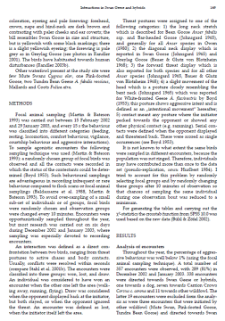- Search in all Repository
- Literature and maps
- Archeology
- Mills database
- Natural sciences
Advanced search
Advanced search
Advanced search
Advanced search
Advanced search

Object
Title: Nest re-use by blackbirds - the way for safe breeding?
Creator:
Wysocki, Dariusz (1961– ) ; Polska Akademia Nauk. Muzeum i Instytut Zoologii
Date issued/created:
Resource type:
Subtitle:
Acta Ornithologica, vol. 39, no. 2 ; Czy ponowne użytkowanie gniazd przez kosy może być sposobem unikania drapieżników?
Contributor:
Museum and Institute of Zoology, Polish Academy of Sciences
Publisher:
Place of publishing:
Description:
Bibliogr. p. 168 ; P. [164]-168 ; 27 cm ; Abstarct in Polish
Type of object:
Abstract:
The biology of individually colour-ringed European Blackbirds inhabiting two city parks in Szczecin (NW Poland) was studied in 1997–2003. In each park one to three observers watched the behaviour of Blackbirds every other day from dawn till afternoon (6–8 h a day); in this way almost all of their nests were discovered. 35 cases were recorded where pairs re-used their own nests, as well as two cases where the nest of another Blackbird pair and one Fieldfare nest were re-used. In 33 out of 81 cases observed, the re-use occurred after the brood had been successfully reared, while in two cases out of 378, female Blackbirds initiated the second breeding attempt in the same nest after the loss of the first one. The re-used nests were better concealed (80 ± 19% and 69 ± 18%, respectively) and had been built at greater heights than those abandoned after breeding (9.0 ± 5.0 m and 6.5 ± 4.2 m, respectively). No shortening of the interval between successive clutches was noted in the case of nest re-use (re-used nests 36.8 ± 4.9 days, newly-built nests 37.7 ± 8.0). The more and more frequent re-use of nests where breeding had been successful, their better concealment and higher sites, and also the lack of any differences in the intervals between successive clutches of pairs occupying old nests and those building new ones before the next breeding attempt, suggest that in the investigated population the basic reason for nest re-use was the insufficient number of safe nesting sites.
Relation:
Volume:
Issue:
Start page:
End page:
Detailed Resource Type:
Format:
Resource Identifier:
Source:
MiIZ PAN, call no. patrz sygn. czas. P.257-39-2 ; MiIZ PAN, call no. patrz sygn. czas. P.4568-39-2 ; click here to follow the link
Language:
Rights:
Terms of use:
Copyright-protected material. May be used within the limits of statutory user freedoms
Digitizing institution:
Museum and Institute of Zoology of the Polish Academy of Sciences
Original in:
Library of the Museum and Institute of Zoology of the Polish Academy of Sciences
Projects co-financed by:
Programme Innovative Economy, 2010-2014, Priority Axis 2. R&D infrastructure ; European Union. European Regional Development Fund
Access:
Object collections:
- Digital Repository of Scientific Institutes > Partners' collections > Museum and Institute of Zoology PAS > Scientific Journals
- Digital Repository of Scientific Institutes > Partners' collections > Museum and Institute of Zoology PAS > MIZ PAN Publications > Acta Ornithologica
- Digital Repository of Scientific Institutes > Literature > Journals/Articles
Last modified:
Feb 4, 2025
In our library since:
Jul 28, 2015
Number of object content downloads / hits:
52
All available object's versions:
https://rcin.org.pl./publication/49789
Show description in RDF format:
Show description in RDFa format:
Show description in OAI-PMH format:
| Edition name | Date |
|---|---|
| Nest re-use by blackbirds - the way for safe breeding? / Wysocki D. | Feb 4, 2025 |
Objects Similar
Wysocki, Dariusz (1961– ) Walasz, Kazimierz (1952– ) Polska Akademia Nauk. Muzeum i Instytut Zoologii
Korycińska, Małgorzata ( –2012) Polska Akademia Nauk. Muzeum i Instytut Zoologii
Smoleński, Marcin (1962– ) Polska Akademia Nauk. Muzeum i Instytut Zoologii
Smoleński, Marcin (1962– ) Polska Akademia Nauk. Muzeum i Instytut Zoologii
Wegner, Elżbieta Polska Akademia Nauk. Muzeum i Instytut Zoologii
Pilipiuk, Irmina Polska Akademia Nauk. Muzeum i Instytut Zoologii
Skrzypczyńska, Małgorzata Polska Akademia Nauk. Muzeum i Instytut Zoologii
Revision of Plastophorides Beyer (Diptera: Phoridae), with two new species from Sulawesi and Palawan
Almond, Edward J. Polska Akademia Nauk. Muzeum i Instytut Zoologii

 INSTYTUT ARCHEOLOGII I ETNOLOGII POLSKIEJ AKADEMII NAUK
INSTYTUT ARCHEOLOGII I ETNOLOGII POLSKIEJ AKADEMII NAUK
 INSTYTUT BADAŃ LITERACKICH POLSKIEJ AKADEMII NAUK
INSTYTUT BADAŃ LITERACKICH POLSKIEJ AKADEMII NAUK
 INSTYTUT BADAWCZY LEŚNICTWA
INSTYTUT BADAWCZY LEŚNICTWA
 INSTYTUT BIOLOGII DOŚWIADCZALNEJ IM. MARCELEGO NENCKIEGO POLSKIEJ AKADEMII NAUK
INSTYTUT BIOLOGII DOŚWIADCZALNEJ IM. MARCELEGO NENCKIEGO POLSKIEJ AKADEMII NAUK
 INSTYTUT BIOLOGII SSAKÓW POLSKIEJ AKADEMII NAUK
INSTYTUT BIOLOGII SSAKÓW POLSKIEJ AKADEMII NAUK
 INSTYTUT CHEMII FIZYCZNEJ PAN
INSTYTUT CHEMII FIZYCZNEJ PAN
 INSTYTUT CHEMII ORGANICZNEJ PAN
INSTYTUT CHEMII ORGANICZNEJ PAN
 INSTYTUT FILOZOFII I SOCJOLOGII PAN
INSTYTUT FILOZOFII I SOCJOLOGII PAN
 INSTYTUT GEOGRAFII I PRZESTRZENNEGO ZAGOSPODAROWANIA PAN
INSTYTUT GEOGRAFII I PRZESTRZENNEGO ZAGOSPODAROWANIA PAN
 INSTYTUT HISTORII im. TADEUSZA MANTEUFFLA POLSKIEJ AKADEMII NAUK
INSTYTUT HISTORII im. TADEUSZA MANTEUFFLA POLSKIEJ AKADEMII NAUK
 INSTYTUT JĘZYKA POLSKIEGO POLSKIEJ AKADEMII NAUK
INSTYTUT JĘZYKA POLSKIEGO POLSKIEJ AKADEMII NAUK
 INSTYTUT MATEMATYCZNY PAN
INSTYTUT MATEMATYCZNY PAN
 INSTYTUT MEDYCYNY DOŚWIADCZALNEJ I KLINICZNEJ IM.MIROSŁAWA MOSSAKOWSKIEGO POLSKIEJ AKADEMII NAUK
INSTYTUT MEDYCYNY DOŚWIADCZALNEJ I KLINICZNEJ IM.MIROSŁAWA MOSSAKOWSKIEGO POLSKIEJ AKADEMII NAUK
 INSTYTUT PODSTAWOWYCH PROBLEMÓW TECHNIKI PAN
INSTYTUT PODSTAWOWYCH PROBLEMÓW TECHNIKI PAN
 INSTYTUT SLAWISTYKI PAN
INSTYTUT SLAWISTYKI PAN
 SIEĆ BADAWCZA ŁUKASIEWICZ - INSTYTUT TECHNOLOGII MATERIAŁÓW ELEKTRONICZNYCH
SIEĆ BADAWCZA ŁUKASIEWICZ - INSTYTUT TECHNOLOGII MATERIAŁÓW ELEKTRONICZNYCH
 MUZEUM I INSTYTUT ZOOLOGII POLSKIEJ AKADEMII NAUK
MUZEUM I INSTYTUT ZOOLOGII POLSKIEJ AKADEMII NAUK
 INSTYTUT BADAŃ SYSTEMOWYCH PAN
INSTYTUT BADAŃ SYSTEMOWYCH PAN
 INSTYTUT BOTANIKI IM. WŁADYSŁAWA SZAFERA POLSKIEJ AKADEMII NAUK
INSTYTUT BOTANIKI IM. WŁADYSŁAWA SZAFERA POLSKIEJ AKADEMII NAUK


































